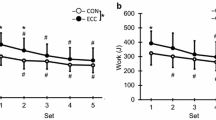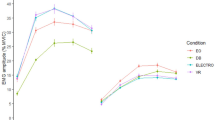Abstract
Series cross-section images of the upper extremity were obtained for four men by magnetic resonance imaging (MRI) and anatomical cross-sectional areas (ACSA) of elbow flexor muscles [biceps brachii (BIC), brachialis (BRA), brachioradialis (BRD)] and extensor muscles [triceps brachii (TRI)] were measured. Physiological cross-sectional area (PCSA) was calculated from the muscle volume and muscle fibre length, the former from the series ACSA and the latter from the muscle length multiplied by previously reported fibre/muscle length ratios. Elbow flexion/extension torque was measured using an isokinetic dynamometer and the force at the tendons was calculated from the torque and moment arms of muscles measured by MRI. Maximal ACSA of TRI was comparable to that of total flexors, while PCSA of TRI was greater by 1.9 times. Within flexors, BRA had the greatest contribution to torque (47%), followed by BIC (34%) and BRD (19%). Specific tension related to the estimated velocity of muscle fibres were similar for elbow flexors and extensors, suggesting that the capacity of tension development is analogous between two muscle groups.
Similar content being viewed by others
References
Amis AA, Dowson D, Wright V (1979) Muscle strengths and musculo-skeletal geometry of the upper limb. Eng Med 8:41–48
An KN, Fui FC, Morrey BF, Linscheid RL, Chao EY (1981) Muscles across the elbow joint. J Biomech 14:659–669
An KN, Kaufman KR, Chao EYS (1989) Physiological considerations of muscle force through the elbow joint. J Biomech 22:1249–1256
Bo WJ, Meschan I, Krueger WA (1980) Basic atlas of cross-sectional anatomy. Saunders, Philadelphia
Bodine SC, Roy RR, Meadows DAA, Zernicke RF, Sacks RD, Fournier M, Edgerton VR (1982) Architectural, histochemical, and contractile characteristics of a unique biarticular muscle: the cat semitendinosus. J Neurophysiol 48:192–201
Brand RA, Pedersen DR, Friedrich JA (1986) The sensitivity of muscle force predictions to changes in physiologic cross-sectional area. J Biomech 19:589–596
Conover WJ (1980) Practical nonparametric statistics. Wiley, New York
Cutts A (1988) Shrinkage of muscle fibres during the fixation of cadaveric tissue. J Anat 160:75–78
Edgerton VR, Roy RR, Apor P (1986) Specific tension of human elbow flexor muscles. In: Saltin B (ed) Biochemistry of exercise VI. Human Kinetics, Champaign, Ill., pp 487–500
Friedrich JA, Brand RA (1990) Muscle fiber architecture in the human lower limb. J Biomech 23:91–95
Fukunaga T, Roy RR, Schellock FG, Hodgson JA, Day MK, Lee PL, Kwong-Fu H, Edgerton VR (1992) Physiological cross-sectional area of human leg muscles based on magnetic resonance imaging. J Orthop Res 10:926–934
Henriksson-Larsen K, Wretling M-L, Lorentzon RL, Oberg L (1992) Do muscle size and fibre angulation correlate in pennated human muscles? Eur J Appl Physiol 64:68–72
Hill AV (1938) The heat of shortening and the dynamic constants of mucsle. Proc R Soc London [Ser B] 126:136–195
Hortobagyi T, Katch FI (1990) Eccentric and concentric torque-velocity relationships during arm flexion and extension. Eur J Appl Phsiol 60:395–401
Ikai M, Fukunaga T (1968) Calculation of muscle strength per unit cross-sectional area of human muscle by means of ultrasonic measurement. Int Z Angew Physiol Einshcl Arbeitsphysiol 26:26–32
Kawakami Y, Hirano Y, Miyashita M, Fukunaga T (1993a) Effect of leg extension training on concentric and eccentric strength of quadriceps femoris muscles. Scand J Med Sci Sports 3:22–27
Kawakami Y, Abe T, Fukunaga T (1993b) Muscle-fibre pennation angles are greater in hypertrophied than in normal muscles. J Appl Physiol 74:2740–2744
Komi PV (1973) Measurement of the force-velocity relationship in human muscle under concentric and eccentric contractions. Med Sport 8:224–229
Komi PV (1979) Neuromuscular performance: factors influencing force and speed production. Scand J Sports Sci 1:2–15
Maughan RJ, Watson JS, Landoni L (1988) Force of knee extensor and flexor muscles and cross-sectional area determined by nuclear magnetic resonance imaging. Eur J Appl Physiol 57:39–44
Narici MV, Roi GS, Landoni L, Minetti AE, Cerretelli P (1989) Changes in force, cross-sectional area and neural activation during strength training and detraining of the human quadriceps. Eur J Appl Physiol 59:319–319
Narici MV, Landoni L, Minetti AE (1992) Assessment of human knee extensor muscles stress from in vivo physiological cross-sectional area and strength measurements. Eur J Appl Physiol 65:438–444
Nygaard E, Houston M, Suzuki Y, Jorgensen K, Saltin B (1983) Morphology of the brachial biceps muscle and elbow flexion in man. Acta Physiol Scand 117:287–292
Rizzardo M, Wessel J, Bay G (1988) Eccentric and concentric torque and power of the knee extensors of females. Can J Sports Sci 13:166–169
Rugg SG, Gregor RJ, Mandelbaum BR, Chui L (1990) In vivo moment arm calculations at the ankle using magnetic resonance imaging (MRI). J Biomech 23:495–501
Rutherford OM, Jones DA (1992) Measurement of fibre pennation using ultrasound in the human quadriceps in vivo. Eur J Appl Physiol 65:433–437
Singh M, Karpovich PV (1966) Isotonic and isometric forces of forearm flexors and extensors. J Appl Physiol 21:1435–1437
Spector SA, Gardiner PF, Zernicke RF, Roy RR, Edgerton VR (1980) Muscle architecture and force-velocity characteristics of cat soleus and medial gastrocnemius: implications for motor control. J Neurophysiol 44:951–960
Spoor CW, van Leeuwen JL (1992) Knee muscle moment arms from MRI and from tendon travel. J Biomech 25:201–206
Thorstensson A, Grimby G, Karlsson J (1976) Force-velocity relations and fiber composition in human knee extensor muscles. J Appl Physiol 40:12–16
Westing SH, Seger JY (1989) Eccentric and concentric torquevelocity characteristics, torque output comparison, and gravity effect torque corrections for the quadriceps and hamstring muscles in females. Int J Sports Med 10:175–180
Westing SH, Seger JY, Karlson E, Ekblom B (1988) Eccentric and concentric torque-velocity characteristics of the quadriceps femoris in man. Eur J Appl Physiol 58:100–104
Wickiewicz TL, Roy RR, Powell PL, Edgerton VR (1983) Muscle architecture of the human lower limb. Clin Orthop Rel Res 179:275–283
Wickiewicz TL, Roy RR, Powell PL, Perrine JJ, Edgerton VR (1984) Muscle architecture and force-velocity relationships in humans. J Appl Physiol Respir Environ Exerc Physiol 57:435–443
Author information
Authors and Affiliations
Rights and permissions
About this article
Cite this article
Kawakami, Y., Nakazawa, K., Fujimoto, T. et al. Specific tension of elbow flexor and extensor muscles based on magnetic resonance imaging. Europ. J. Appl. Physiol. 68, 139–147 (1994). https://doi.org/10.1007/BF00244027
Accepted:
Issue Date:
DOI: https://doi.org/10.1007/BF00244027




